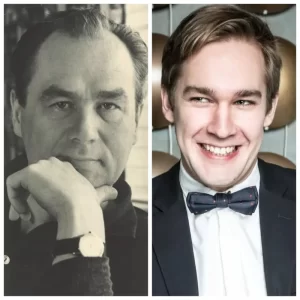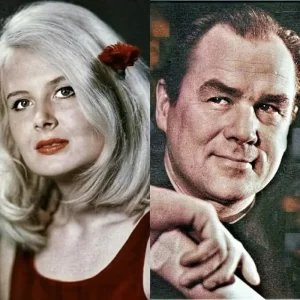A renowned guy with a velvety baritone that could reach right into the soul, he was also a gifted artist and pop vocalist. Georg Ots had no competitors: he sung and played opera parts equally skillfully, switching between genres with ease—whether it was the upbeat “Song about the Captain” or the dramatic “An aria for Mr. X.”
Childhood
Ots is a singer and musician from the fourth generation. Tõnu Ots, Georg’s great-grandfather, was a superb violinist; his grandpa Hans led a choir, played the piano and organ, and brought theater enthusiasts in Narva together. Tenor Karl Ots, the father of the unrivaled Mr. X, was a soloist in the Tallinn theater after earning his degree from the St. Petersburg Conservatory.
Georg was born in Petrograd in the spring of 1920, but the young family relocated to Tallinn not long after he was born. The boy drank his mother’s milk, taking in singing and music. From an early age, he received attention in his musical instruction. After being sent to the French Lyceum, Ots studied the trombone, piano, and flute in addition to participating in the choir.
Instructors discovered that a first-grader was an opera star in training. Six-year-old Georg sang an Italian aria that he had learned from listening to his father when the instructor, who was evaluating the kids’ vocal skills, asked him to. It came to light that the young singer’s “repertoire” consisted of numerous opera arias that his parents had committed to memory.
But young Ots was drawn to athletics just as much as music. The youngster joined the swimming club, developed a passion in fencing and basketball, and in 1939, after swimming the first 1500 meters, won the republican championship.
Following his time at the French Lyceum, the young man considered his future career. My father suggested picking a “more respectable” career because he was aware of the difficulties an opera singer faces. Georg attended a military school as a young man and aspired to be an architect. The young man completed his first year at a Tallinn technical university in 1941.
Georg, then twenty-one, was drafted into the army and brought on ship to the city on the Neva to form an army unit. 180 kilometers from Leningrad, in the Gulf of Finland, a German aircraft attacked the Sibir ship. Because the young man could swim well, he was able to avoid certain death and remain in the water until a minesweeper picked him up.
Georg Ots was transported from Leningrad to the Chelyabinsk area with the mobilization, where he assumed command of an anti-tank platoon. However, by happenstance, Georg met a fellow countryman who was the creative director of Estonian ensembles and chose performers to present their work to the nation’s protectors.
Georg’s artistic career started in the mixed choir of Gustav Ernesaks and continued with the jazz orchestra, where he performed as soloist Viktor Guryev’s pianist. In a military hospital, Ots made his solo performance debut by singing a number of tunes to the injured.
Music
Georg went on tour with Estonian groups, touring Siberia, the Caucasus, Central Asia, and the White Sea coast, where they performed at more than 400 concerts. Renowned vocal instructor Nazariy Raisky saw and complimented the gifted singer Otsa during a big concert the Estonians staged in the spring of 1944 at the Tchaikovsky Concert Hall in the capital.
Georg enrolled in the City Music School shortly after and completed his studies there in two years as an external student. Ots later graduated from the Tallinn Conservatory in 1951 with a diploma. Excellent Estonian baritone Tiit Kuusik, the artist’s conservatory teacher, demonstrated the breadth of the student’s abilities by providing vocals for him.
Ots worked at the Estonia Opera and Ballet Theater while pursuing his education. Georg was first assigned supporting roles in operettas and operas before being promoted to major ones.
Following a redesign in the late 1940s, the theater adopted a musical theme. Eugene Onegin, an opera, opened the season. Georg had to sing Onegin’s arias because the main vocalist was ill, and he performed a fantastic job. The performance became a mainstay in the performer’s repertoire for many years. Ots won the Stalin Prize for her performance, and in 1950 he rose to prominence as the theater’s principal soloist.
Light pop tunes were introduced to the vocalist’s repertoire in the years following World War II. The Estonian singer’s velvety baritone gave many of the compositions a zesty new interpretation during the singer’s performance. The performer’s repertoire grew to fifty thousand pop tunes over time, ranging from comical to patriotic. Without Georg Karlovich’s soulful baritone singing “Sevastopol Waltz,” “Sormovo Lyric,” “I Love You, Life,” and other songs, a concert was almost never complete.
Otsu received the challenging aria from the opera of the same name, which is performed by the Demon, in 1953 from the renowned Soviet theatrical director Alexander Viner. The artist took inspiration from Mikhail Vrubel’s paintings and Mikhail Lermontov’s work to obtain a sense of the part. Afterwards, Georg acknowledged that the period he worked on the role was among the most fascinating of his entire theatrical career.
The repertoire of the Estonian-Russian baritone contained works in twenty different languages. In order to preserve the essence of the song during translation, Ots insisted on playing folk pieces in their original tongue.
The singer performed “Saaremaa Waltz” in his native tongue; it is the song that is most well-known there. The waltz persisted in playing on the radio even after the Soviet Union collapsed and Estonia became a sovereign state, marking the rejection and crossing out of everything Soviet. And even after his passing, the musician’s discography continued to grow.
Movies
Ots made his screen debut in 1951. In the drama “The Light in Cordi” by Herbert Rappaport, he portrayed Paul Runge, a farm laborer who serves as the main character. The storyline reveals that a man, demobilized from the Red Army during the Great Patriotic War, returns to his hometown with the intention of improving it.
Some reports indicate that the filmmakers especially brought in a communal farmer from Estonia to serve as a backup during sequences involving intense physical labor in the field, intending for him to replace Georg. However, upon learning of this, Ots firmly rejected the idea, took up a plow, and plowed the ground himself. The understudy, who also served as a consultant in the movie, greatly praised the actor’s fieldwork.
Thereafter, Georg’s filmography frequently expanded with performance pictures.The middle of the 1960s marked Ots’s true breakthrough when the Lenfilm studio released Yuli Khmelnitsky’s musical film “Mr. X,” inspired by Imre Kalman’s operetta “The Circus Princess.” The captivating storyline, combined with the singer’s distinct charisma and mesmerizing voice, quickly elevated him to global celebrity status. The entire nation sang the songs that the Estonian performed in the movie, turning Ots’s role in the melodrama into a priceless gem in his creative portfolio.
Individual existence
The artist’s private life stirred turmoil and drama, marked by turbulence. The war and his young wife’s infidelity shattered Ots’s pre-war marriage to Margot, a girl. They spent only six months together until Georg’s military call-up in 1941. Shortly after, Margot received a mistaken notice of his death. However, her grief quickly turned into an affair with an adjutant from the German commandant’s office. Eventually, she fled to Canada at the war’s end, leaving a trail of scandal and intrigue.

After the war, Georg Karlovich remarried, this time to ballerina Asta Saar, whom he had met on the set. They had a brief but intense courtship before getting married and enjoying a 20-year marriage. Georg and Asta performed together on the Estonia Theater stage. Asta bore two children: Yulo, a son, and Yulle, a daughter.
Their marriage ended in divorce in the mid-1960s. Rumors circulated about Georg’s alleged affair with actress Ewe Kivi in the late 1960s, but it remains uncertain whether they were true.
During the same period, Georg Karlovich met Ilona, a stunning fashion model twenty years his junior. Her image adorned the covers of glossy publications. Ilona later admitted that Georg’s charm appealed to women of all ages. She devoted herself entirely to him, even quitting her job to avoid provoking jealousy in her spouse. Marianna, their daughter, was born shortly afterward, but their marriage lasted only 11 years.
Death
A brain tumor, discovered early in the 1970s, caused the artist to pass away. Georg Karlovich underwent eye amputation and faced eight difficult surgeries. Hardly recuperating from his illness, he immersed himself in his work.
In the two years fate allowed him after the surgery, Ots accomplished a great deal. He made appearances in the Russian capital, where people still cherished him, gave a concert in the city on the Neva, played major roles in the opera La Traviata and the movie Cola Breugnon, and toured Europe with a theater group.
The artist died early in the autumn of 1975. Many famous people and notable Estonian politicians share the Tallinn Forest Cemetery, where they buried Ots.
